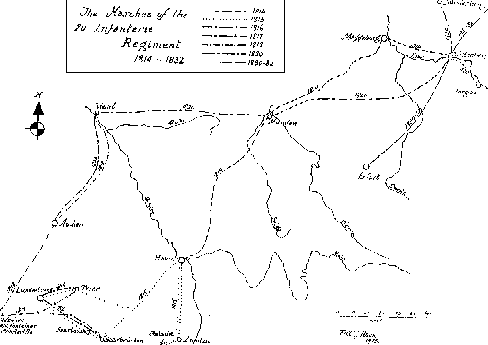
With the return of the Emperor Napoleon from exile in Elba, the war with France was renewed, but the new 20 Infanterie-Regiment was not amongst those called upon to take the field. As assigned, it remained in the garrison of the fortress of Mainz.
On the 18th of June, the very day of the battle at Belle-Alliance (Waterloo), came their marching orders - but only to join the siege of the fortified town of Landau. On the 20th of June, they crossed the Rhine, advancing through the beautiful and fruitful Pfalz region. General Krauseneck was nominated as commander of the besieging forces. The siege amounted to small patrols and outpost lines between Merlenheim, Queichheim and Dammheim, and gained no distinction for the Regiment. In July, the Fusilier Battalion was detached to the investment of the hill fortress of Bitsch; no action occurred, and they returned to Landau at the end of August.
After the news of the entry of the Allies into Paris, and the capture of Napoleon, all hostilities ended. The commander of the fortress, General Geuder, declared for Louis XVIII, relinquished his command and marched out with his National Guard troops at the beginning of September.
The real victory celebrations for the two Musketier battalions came with the presentation of their first colours, by order of the Supreme Cabinet dated 13th June, by General Krauseneck. The colours were draped with the commemorative ribbon for the War of Liberation (1813-1814); after a drumhead service, a short address and a cheer for His Majesty the King of Prussia, both battalions marched past with their new colours.
In October 1815, the Prussian troops at Landau were relieved by the Austrian Mazuchelli Brigade, and marched back towards their garrison post at the fortress of Mainz. In the last days of November, the 20. Regiment left Mainz for new garrisons: I Battalion at Trier, II Battalion at Saarlouis and the Fusilier Battalion at Saarbrucken.
Once again in December 1815, the Regiment left to take up residence as the new garrison at Luxembourg. Despite the end of the war against Napoleon, the Allies were to retain large numbers of troops in and around France in the army of occupation until 1819.
Thus the 20 Infanterie Regiment returned to Trier and Saarlouis in 1816, as part of the Steinmetz Brigade of III Army Corps. By Cabinet Order of 9th January 1816, the Regiment changed their shoulder straps from yellow to red with yellow embroidered numbers, which they were to retain up to 1914. In the spring of 1816, the first reservists began their return home.
On the 28th August 1816, the Fusilier Battalion received its colours with much rejoicing from the Regimental Commander, Oberst von Natzmer.
By Cabinet Order of 5th November 1816, the regimental designation changed to: 20 Infanterie-Regiment (3 Brandenburgisches)
The next year, 1817, the Regiment went back to France, brigaded along with the 12 Infanterie-Regiment (2 Brandenburgisches) under Oberst von Lettow, serving in the Observation Corps occupying France under General Graf von Ziethen. On the 2nd of August, they crossed the frontier and took up garrison at Mezieres, Septfontaines and Charleville. They were to remain there until November 1818, when they returned to Germany, but only as far as Wesel and Aachen. Not until 1820, was the Regiment to return to its recruiting ground in Brandenburg.
On the 3rd of April, 1823, the Regiment's first commander in the field, General Graf Tauentzien von Wittenberg, became their Colonel-in Chief. This recognition of their finest hour (to date) was complimented by the title awarded their old chief by a grateful King.
Perhaps the old 8th Reserve Regiment
did not serve in the thick of the famous battles
of the period, but not many did and lived to
record a coherent tale of their deeds. The wars
of Napoleon did not terminate at Waterloo,
although that victory made it impossible for
him to continue the struggle; others were to do
that for years to come, not only at Landau in
1815, but all the way to the restoration of the
Empire and its final debacle in 1870.

Back to Table of Contents -- First Empire 26
© Copyright 1996 by First Empire.
This article appears in MagWeb (Magazine Web) on the Internet World Wide Web.
Other military history articles and gaming articles are available at http://www.magweb.com